Timeline of mosquito net distribution
Jump to navigation
Jump to search
This is a timeline of bed net distribution, a strategy deployed widely to reduce the incidence of malaria in tropical countries.
Big picture
| Period | Key developments |
|---|---|
| Ancient times < | Use of mosquito nets is documented in the Mediterranean world.[1] Evidence also indicates their use in Japan.[2] |
| 19th century | British colonists in India adopt sleeping under nets (likely inspired by the example of Punjabi fishermen).[3] |
| 1940s | Textiles and insecticides start to be combined, during World War II.[3] |
| 1970s–1980s | Contemporary with the decline of DDT-based indoor residual spraying, interest in insecticide-impregnated nets as a malaria control tool reemerges.[3][4] |
| 1990s | Insecticide treated nets (ITN) start to be used early in the decade.[5] By the mid-1990s, ITNs already become an important component of global and national malaria control policies.[6] |
| 2000s | Mosquito net distribution develops at a large scale. The number of ITNs delivered by manufacturers to malaria endemic countries in Sub-Saharan Africa increases from 6 million to 145 million between 2004 and 2010.[7] Between 2000 and 2011, the share of households owning at least one treated net in SSA is estimated to have risen from 3% to 50%.[8] |
Full timeline
| Year/period | Type of event | Event | Location |
|---|---|---|---|
| 484–?425 BC | Antecedent | Greek historian Herodotus describes how Egyptians living in marshy lowlands protect themselves with fishing nets.[3] | Egypt |
| 1603–1868 | Antecedent | By the early Edo period, mosquito nets are a standard summer item found in houses at all social levels in Japan.[2] | Japan |
| 1939–1945 | Antecedent | The Soviet army applies juniper oil to bednets to repel mosquitoes and sand flies bearing malaria and leishmaniasis during campaigns in Central Asia. Meanwhile, the American military impregnates bednets and jungle hammocks with 5 percent DDT to prevent malaria and filariasis during campaigns in the Pacific.[3] | Asia, Western Pacific |
| 1980 | Development | Proven to be an extremely effective option for people living in insects borne diseases prone areas, the concept of insecticide-treated net is developed to prevent the malaria outbreak in tropical weather countries.[9] | |
| 1983 | Development | A group of experts recommend the use of protective bed nets for preventing malaria, and that the efficacy of bednets impregnated with pyrethroid insecticides should be investigated.[10] | |
| 1986 | Development | Drug treated mosquito nets are first tested in Bangladesh in a number of areas in Sylhet and Chittagong divisions. The test becomes successful.[11] | Bangladesh |
| 1997 | Program launch | Kenya introduces the KEMRI/CDC Bed-net project, (executed in the Bondo District), aimed at the trial of insecticide treated bed nets (ITBNs) in the prevention of malaria. A randomized controlled trial (RCT) is started in Rarieda Division with a baseline work in 1996 followed by the issuing of insecticide treated bed-nets in 1997.[12] | Kenya |
| 1999 | Coverage | Bed net ownership covers 2.2% of the African at-risk population.[13] | |
| 1999 | Coverage | Bed net coverage reaches the 51% of the population in Solomon Islands.[14] | Solomon Islands |
| 2000 | Coverage | 24% of the population in Laos is estimated to sleep under a bed net.[14] | Laos |
| 2000 | Coverage | The percentage of households owning at least one ITN in Sub Saharan Africa is estimated at 3%.[7] | Sub-Saharan Africa |
| 2001 | Program launch | New national strategy for malaria control is developed by the Ministry of Health of Kenya, targeting increased coverage of insecticide treated mosquito nets.[15] | Kenya |
| 2001–2006 | Policy | The World Health Organization approves mosquito net "Olyset", classified as Long Lasting Insecticidal Net (LLIN). Its chemical coating remains active for a minimum of five years. Olyset was first conceived in 1978. By 2006, the net is mass produced as part of a WHO international anti-malaria campaign, focussing particularly in Africa.[16] | |
| 2003 | Distribution | Insecticide treated nets start to be distributed free-of-charge in Cameroon.[17] | Cameroon |
| 2004 | Organization | Against Malaria Foundation (AMF), a United Kingdom-based charity that provides long-lasting insecticidal nets (LLINs) to populations at high risk of malaria, is founded. The organization operates primarily in Africa.[18] | United Kingdom (London) |
| 2004–2006 | Coverage | A near ten-fold increase in the number of young children sleeping under insecticide-treated mosquito nets was observed in targeted districts in Kenya, resulting in 44% fewer deaths than among children not protected by nets, according to preliminary data from the Government.[15] | Kenya |
| 2004–2007 | Production | An increase from 30 million ITNs in 2004 to 95 million ITNs in 2007 is shown by UNICEF data during the period.[19] | |
| 2005 | Organization | The African Summit on Roll Back Malaria is held in Abuja. The summit sets a target for expanding ITN use in Africa—at least 60% coverage of high-risk groups by the year 2005.[20] | Nigeria |
| 2005–2006 | Distribution | Over 2 million mosquito nets are distributed in Niger to combat malaria Distribution begins in 2005 in a campaign supported by an $11 million grant from the UN-backed Global Fund to Fight AIDS, Tuberculosis and Malaria, as well as by $2 million from the Canadian International Development Agency.[21] | Niger |
| 2006 | Distribution | Kenyan President Mwai Kibaki launches a two campaigns effort, funded by a US$ 17 million grant from the Global Fund to Fight AIDS, Tuberculosis and Malaria, to distribute 3.4 million long-lasting insecticidal nets free of charge to children in 45 of Kenya's 70 districts through.[15] | Kenya |
| 2006 | Program launch | Nothing But Nets is launched as a campaign to raise awareness and funding to fight malaria. It allows any individual to volunteer by giving $10 to send a net. Nothing But Nets works with partners like UNICEF, the UN Refugee Agency, and the World Health Organization.[22] | |
| 2006–2007 | Coverage | It is reported that across 18 African countries, 34% of households own an insecticide-treated net and 23% of children
under five sleep under an ITN.[19] || | |
| 2007 | Policy | The World Health Organization starts recommending only use of long lasting insecticide-treated nets (LLINs) and not conventional insecticide treated nets (ITNs).[7] | |
| 2007 | Distribution | Over 1.8 million nets are distributed to thousands of children in Mali.[23] | Mali |
| 2007–2008 | Distribution | Mass campaigns to distribute treated mosquito nets begin in the Democratic Republic of Congo, in which 97% of the people are calculated to live in areas where malaria is endemic. Distribution is carried out mainly in the rural provinces of Bas-Congo and Sud-Kivu, followed by Equateur and urban Kinshasa. Before the first net distribution campaign, net coverage was reported at 19% in children and 20% in women. By 2010, a new survey showed corresponding figures of 38% and 43%, respectively.[24] | Democratic Republic of Congo |
| 2007–2010 | Distribution | 14.1 million treated bed nets are distributed in Nigeria, supported by the World Bank.[24] | Nigeria |
| 2008 | Coverage | Bed net ownership in Africa covers 32.8% of the at-risk population.[13] | Africa |
| 2008 | Distribution | Over 8.7 million nets are distributed in Tanzania under a $63 million program funded by a group of donors, including the Global Fund, DFID, Swiss Development Cooperation, and the World Bank.[25] | Tanzania |
| 2008–2010 | Coverage | 254 million insecticide treated nets (ITNs), most of them long lasting insecticide treated nets (LLINs), are distributed in Sub-Saharan Africa.[26] | Sub-Saharan Africa |
| 2009 | Program launch | Mozambique develops a novel bed net distribution model to increase coverage, based on assumptions about sleeping patterns.[27] | Mozambique |
| 2009 | Distribution | 1.3 million treated nets are distributed in India under World Bank-supported project.[24] | India |
| 2009–2012 | Distribution | 60 million ITNs are distributed outside Africa, with 10 countries accounting for 75% of the total (India 9.2 million, Indonesia 6.1 million, Myanmar 5.4 million, Bangladesh 4.7 million, Afghanistan 4.3 million, Cambodia 3.6 million, Papua New Guinea 3.2 million, Haiti 3.0 million and Philippines 3.0 million)"[7] | India, Indonesia, Myanmar, Bangladesh, Afghanistan, Cambodia, Papua New Guinea, Haiti |
| 2010 | Distribution | The World Bank finances of $30 million for malaria in Zambia, enabling 800,000 nets to be delivered in the country.[24] | Zambia |
| 2010 | Program launch | The Nigerian government launches a campaign to provide bed nets to every household in the nation. A bed-net coupon entitles a household to two free nets.[28] | Nigeria |
| 2010–2011 | Distribution | Over 17 million nets are distributed in Tanzania. The total cost of the campaign is $96.4 million, financed primarily by the Global Fund for AIDS, Tuberculosis and Malaria. Distribution and logistics are handled by the manufacturer and NGOs. By 2011, Tanzania would reach over 80 percent ITN ownership.[25] | Tanzania |
| 2010–2011 | Distribution | Sierra Leone adopts the goal of universal coverage with long-lasting treated mosquito nets, starting a mass net distribution campaign by the National Malaria Control Programme. Approximately 3.2 million mosquito nets treated with insecticide are distributed to families across the country, meeting the target of one net for every two people in the country, as set by the Roll Back Malaria Partnership. By June 2011, according to survey, 87 percent of all households in Sierra Leone own at least one ITN.[8] | Sierra Leone |
| 2011 | Coverage | The percentage of households with any mosquito net in Mozambique reaches 57.0%, with the percentage of households with any insecticide-treated net at 51.4%, and percentage of insecticide-treated nets 50.2%.[29] | Mozambique |
| 2011 | Distribution | In an effort to reduce the significant morbidity and mortality burden of malaria, Cameroon and its health partners distribute over eight million free long-lasting insecticide treated nets (LLINs) in the country.[30] | Cameroon |
| 2012 | Program launch | Malawi implements a universal bed net campaign, during the course of ongoing clinical studies of malaria among pregnant women in the country.[31] | Malawi |
| 2012 | Coverage | The percentage of households owning at least one insecticide treated net in Sub-Saharan Africa is estimated at 56%, up from a 3% in 2000.[7] | Sub-Saharan Africa |
| 2012 | Distribution | A national bed net distribution is implemented in response to reports of high rates of malaria transmission after the 2010 earthquake in Haiti. The Global Fund (GF) sponsors a national distribution of LLINs outside of Port-au-Prince with the goal of two Olyset LLINs per household.[32] | Haiti |
| 2012–2014 | Distribution | 2,560,216 insecticide-treated nets (935,997 in antenatal visits and 1,624,419 in universal coverage campaigns) are distributed in 2012 throughout Mozambique by the National Malaria Control Program (NMCP). In 2013, 3,098,675 insecticide-treated nets are distributed (885,023 in antenatal visits and 2,213,652 in campaign). In 2014, 5,672,392 insecticide-treated nets are distributed (1,258,998 in antenatal visits and 4,413,404 in campaign)"[29] | Mozambique |
| 2013 | Coverage | In Sub-Saharan Africa, 44%of the population at risk is covered by insecticide treated nets, indicating that 90% of people use the nets available to them. At the same time, 278 million of the 840 million people at risk of malaria in the region live in households without even a single Itn.[33] | Sub-Saharan Africa |
| 2014 | Distribution | An estimated 214 million long-lasting insecticidal nets (LLINs) (a record number[33]) are delivered in Africa, bringing the total number of LLINs delivered to that region since 2012 to 427 million.[34] | Africa |
| 2015 | Distribution | UNICEF, one of the largest buyers of mosquito nets in the world, delivers 22.3 million long-lasting insecticidal nets (LLINs) in 30 different countries.[35] | |
| 2016 | Distribution | Against Malaria Foundation funds 10.7 million long-lasting insecticidal nets (LLINs) for distribution in Uganda’s upcoming universal coverage campaign (UCC), in an agreement with the Ministry of Health.[36] | Uganda |
Visual Data

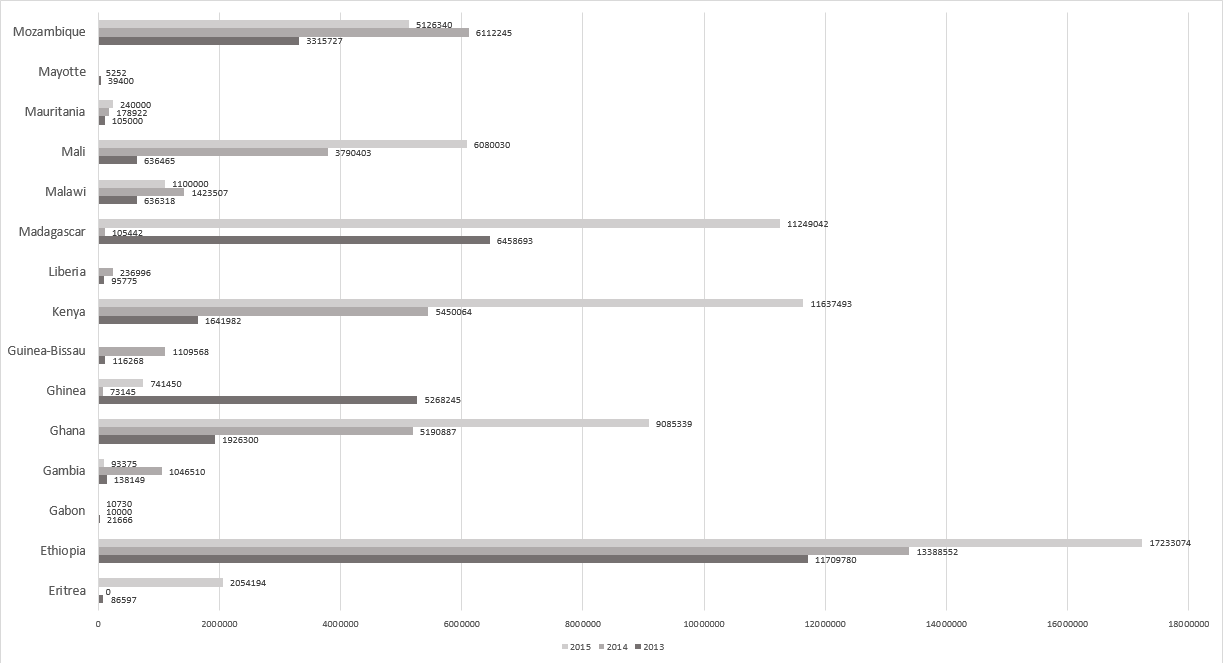

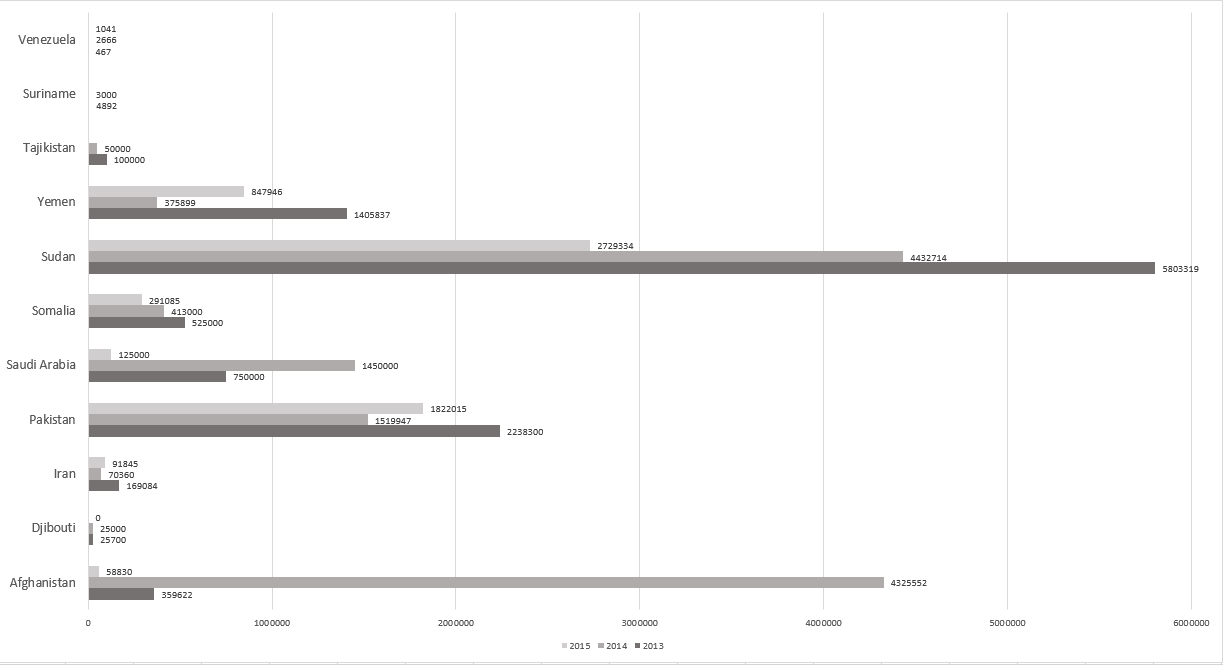
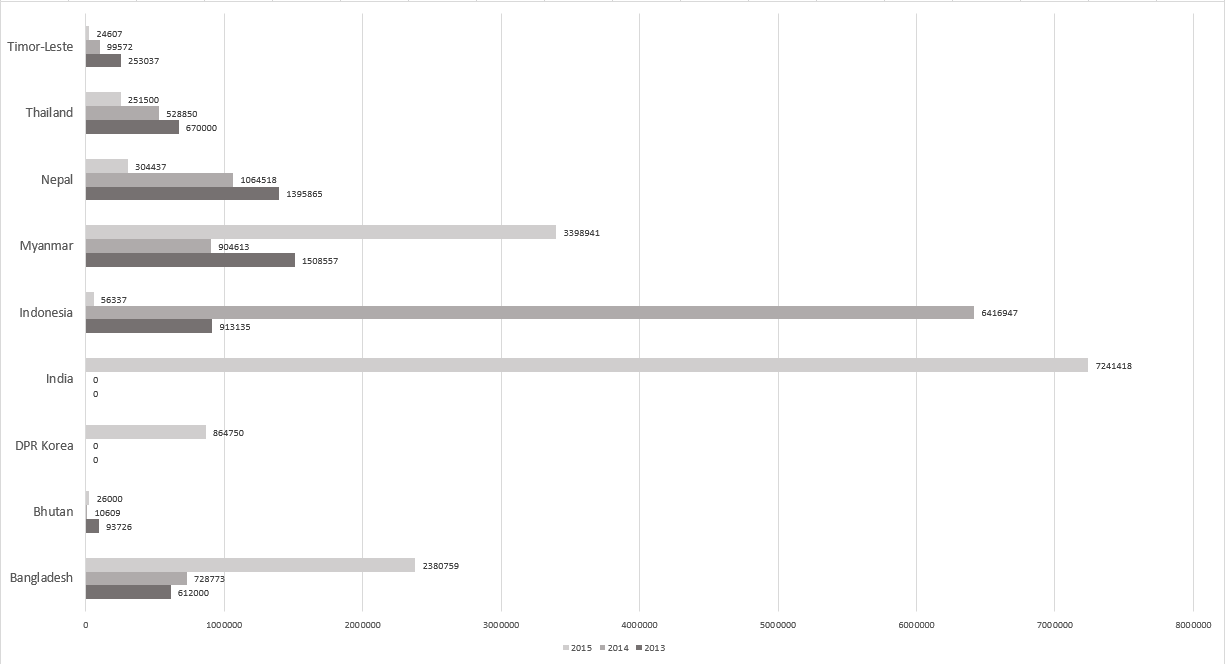
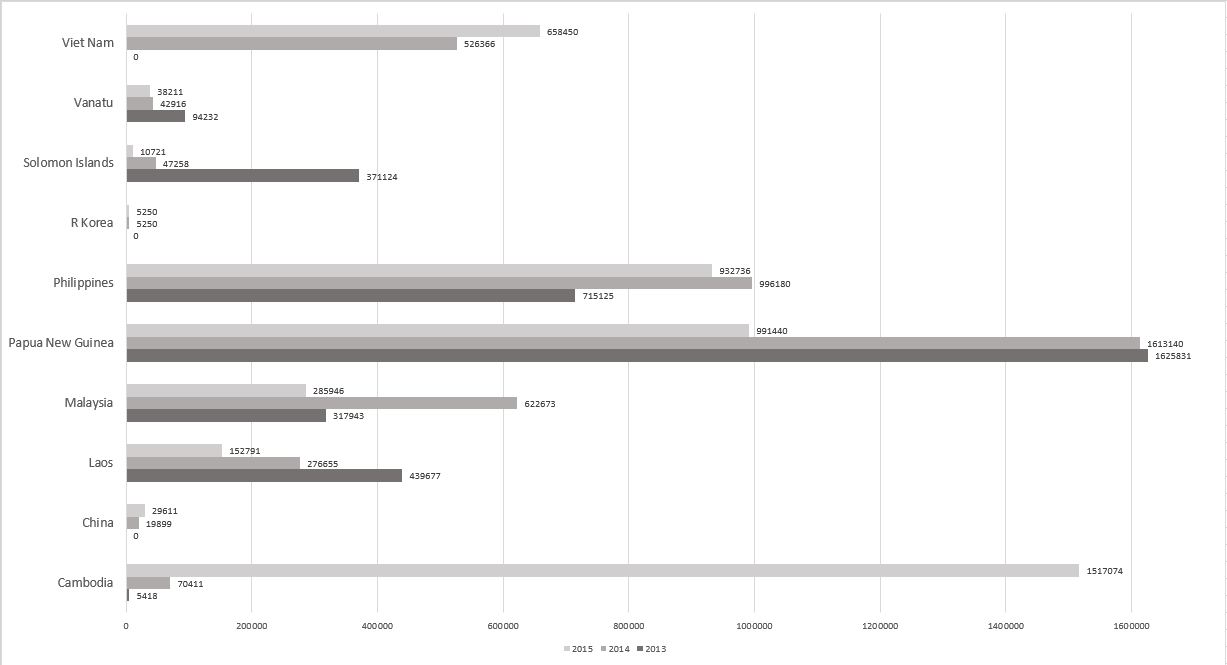
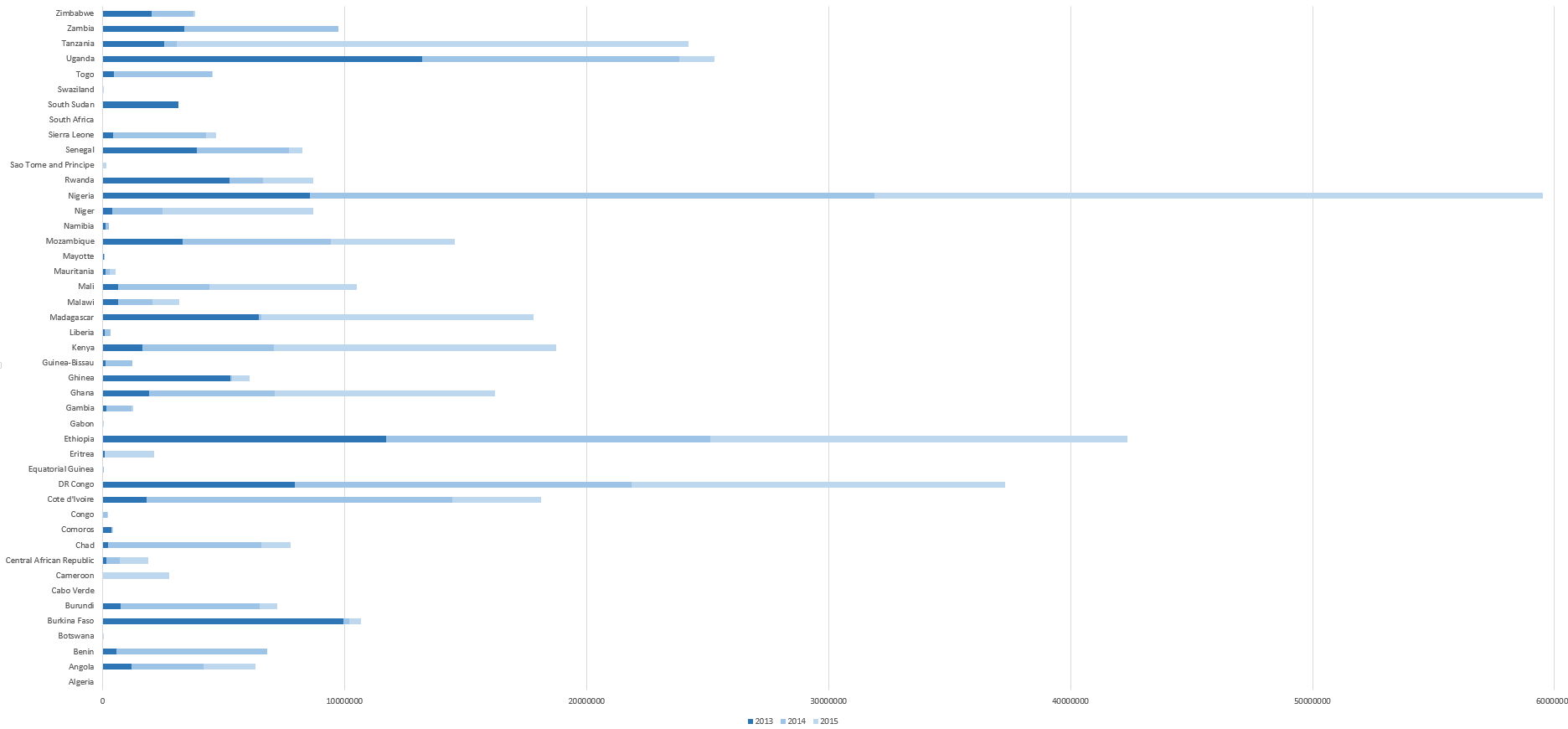
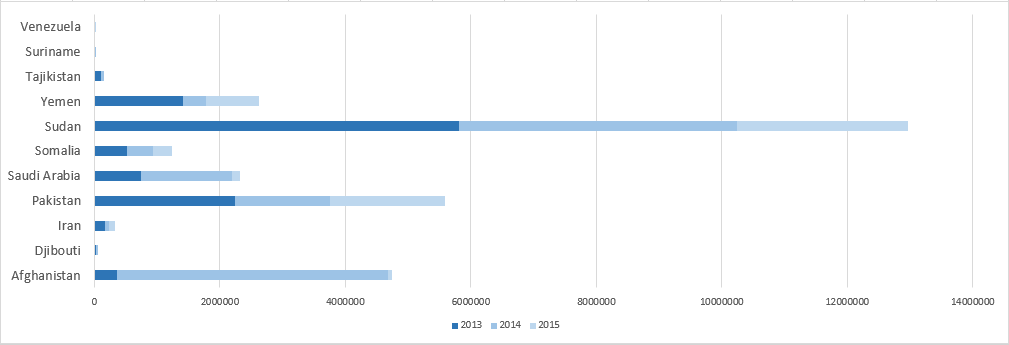

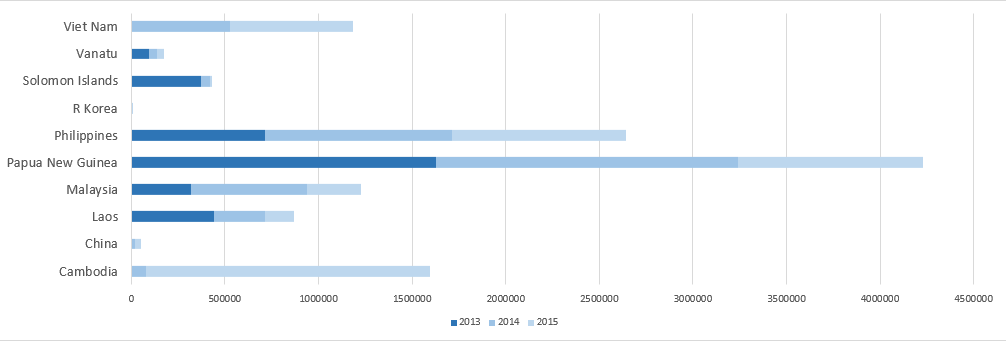
Visual data
Google Trends
The comparative chart below shows Google Trends data for Mosquito net (Topic) and Mosquito net (Search term), from January 2004 to March 2021, when the screenshot was taken. Interest is also ranked by country and displayed on world map.[38]
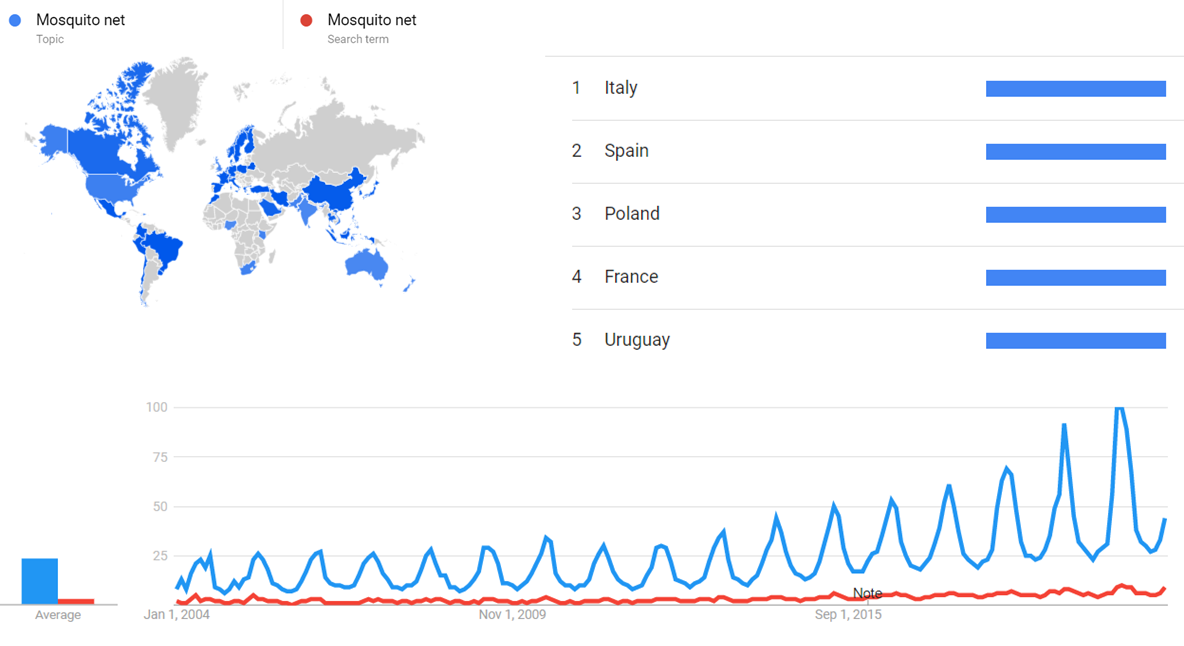
Google Ngram Viewer
The chart below shows Google Ngram Viewer data for Mosquito net, from 1800 to 2019.[39]
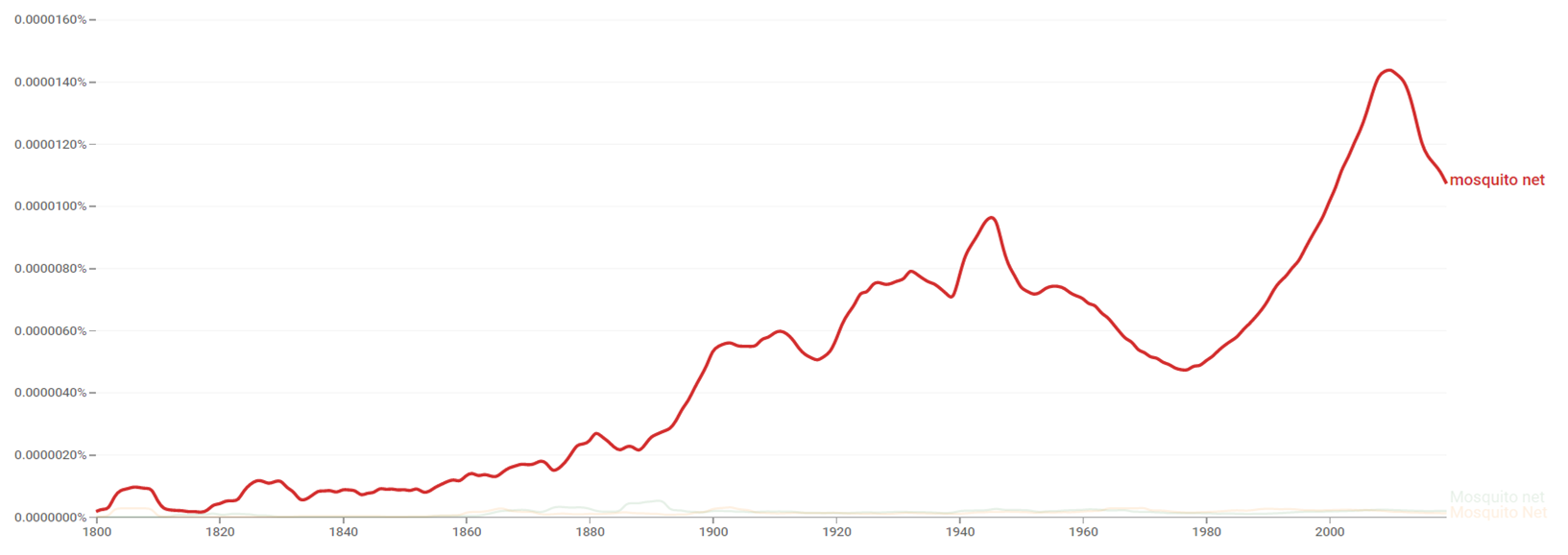
Wikipedia Views
The chart below shows pageviews of the English Wikipedia article Mosquito net, on desktop from December 2007, and on mobile-web, desktop-spider, mobile-web-spider and mobile app, from July 2015; to February 2021.[40]
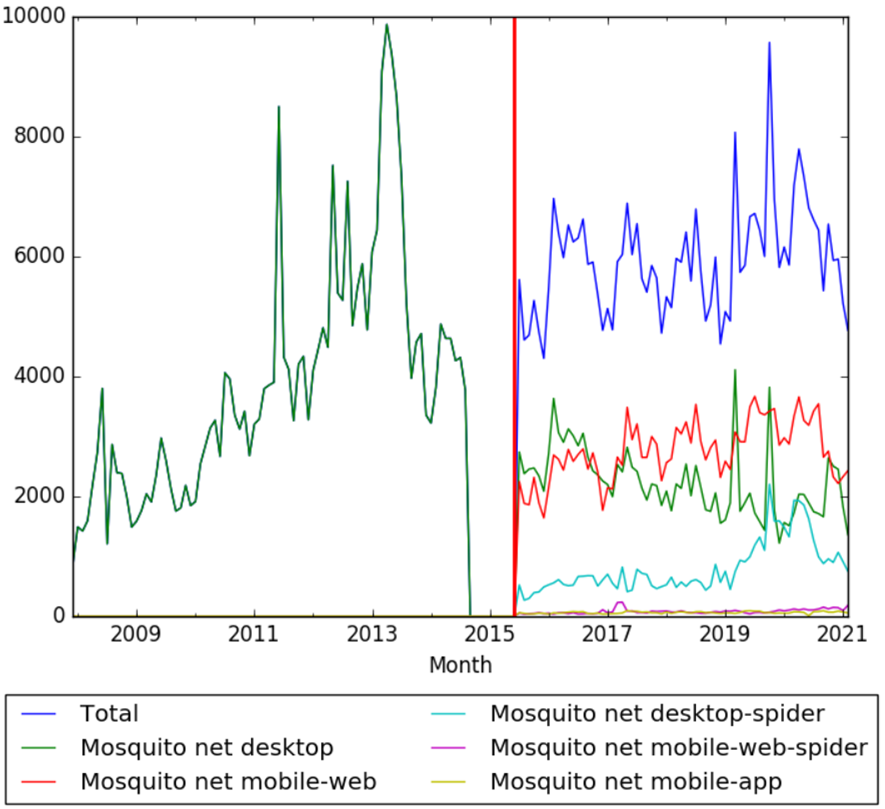
See also
- Timeline of malaria
- Timeline of global health
- Combined timeline of malaria organizations (includes a column on mosquito net distribution that gives salient facts by year from this timeline)
References
- ↑ Riddle, J. Goddesses, Elixirs, and Witches: Plants and Sexuality throughout Human History. Retrieved 15 April 2017.
- ↑ 2.0 2.1 Deal, William E. Handbook to Life in Medieval and Early Modern Japan. Retrieved 15 April 2017.
- ↑ 3.0 3.1 3.2 3.3 3.4 "Saving Lives, Buying Time: Economics of Malaria Drugs in an Age of Resistance". Institute of Medicine (US). Retrieved 15 April 2017.
- ↑ "Mosquito netting for beds". pestnet.com. Retrieved 9 April 2017.
- ↑ "Child Coverage with Mosquito Nets and Malaria Treatment from Population-based Surveys in African Countries: A Baseline for Monitoring Progress in Roll Back Malaria". Retrieved 9 April 2017.
{{cite journal}}: Cite journal requires|journal=(help) - ↑ Hill, J; Rowland, M.; Lines, J. "Insecticide-treated nets". Retrieved 6 April 2017.
{{cite journal}}: Cite journal requires|journal=(help) - ↑ 7.0 7.1 7.2 7.3 7.4 Barrera, Roberto (ed.). "Benefit of Insecticide-Treated Nets, Curtains and Screening on Vector Borne Diseases, Excluding Malaria: A Systematic Review and Meta-analysis". doi:10.1371/journal.pntd.0003228. PMC 4191944. Retrieved 6 April 2017.
{{cite journal}}: Cite journal requires|journal=(help)CS1 maint: unflagged free DOI (link) - ↑ 8.0 8.1 "Sierra Leone Fights Malaria with Mass Distribution of Treated Mosquito Nets". worldbank.org. Retrieved 9 April 2017.
- ↑ "Mosquito Nets – Protection Against Those Pesky Mosquitos". mosquitonetind.in. Retrieved 7 April 2017.
- ↑ "Bed nets that kill mosquitoes" (PDF). who.int. Retrieved 9 April 2017.
- ↑ "Insecticide needed for medicated mosquito nets not available". thedailystar.net. Retrieved 9 April 2017.
- ↑ "Village bednet committees: evaluation of performance, use and maintenance of insectcide-treated bednets in rarieda, western Kenya". ku.ac.ke. Retrieved 10 April 2017.
- ↑ 13.0 13.1 "African countries rapidly distribute bed nets to fight malaria". healthdata.org. Retrieved 6 April 2017.
- ↑ 14.0 14.1 Ricci, Francesco. "Social Implications of Malaria and Their Relationships with Poverty". doi:10.4084/MJHID.2012.048. Retrieved 10 April 2017.
{{cite journal}}: Cite journal requires|journal=(help) - ↑ 15.0 15.1 15.2 "WHO releases new guidance on insecticide-treated mosquito nets". who.int. Retrieved 6 April 2017.
- ↑ "'Olyset' mosquito net in original packaging, Japan, 2005"". sciencemuseum.org.uk. Retrieved 7 April 2017.
- ↑ "Assessing the effective use of mosquito nets in the prevention of malaria in some parts of Mezam division, Northwest Region Cameroon". Malaria Journal. Retrieved 7 April 2017.
- ↑ "Against Malaria Foundation" (PDF). againstmalaria.com. Retrieved 12 April 2017.
- ↑ 19.0 19.1 "THE GLOBAL MALARIA ACTION PLAN" (PDF). unhcr.org. Retrieved 26 October 2019.
- ↑ "Scaling-up insecticide-treated netting programmes in Africa" (PDF). unicef.org. Retrieved 6 April 2017.
- ↑ "More than 2 million mosquito nets distributed as Niger battles malaria: UN". un.org. Retrieved 9 April 2017.
- ↑ "Nothing But Nets". nothingbutnets.net. Retrieved 12 April 2017.
- ↑ "Long-Lasting Insecticide Bed Net". redcross.ca. Retrieved 6 April 2017.
- ↑ 24.0 24.1 24.2 24.3 "Malaria Campaign: Millions Receive Treated Mosquito Nets". worldbank.org. Retrieved 9 April 2017.
- ↑ 25.0 25.1 "The Impact of Mass Bed Net Distribution Programs on Politics: Evidence from Tanzania" (PDF). berkeley.edu. Retrieved 7 April 2017.
- ↑ "Cost and cost effectiveness of long-lasting insecticide-treated bed nets - a model-based analysis". doi:10.1186/1478-7547-10-5. Retrieved 9 April 2017.
{{cite journal}}: Cite journal requires|journal=(help)CS1 maint: unflagged free DOI (link) - ↑ "Evaluation of a universal coverage bed net distribution campaign in four districts in Sofala Province, Mozambique". Malaria Journal. doi:10.1186/1475-2875-13-427. Retrieved 6 April 2017.
{{cite journal}}: CS1 maint: unflagged free DOI (link) - ↑ "Looking to the Future". amnh.org. Retrieved 25 October 2019.
- ↑ 29.0 29.1 "Assessment on the ownership and use of mosquito nets in Mozambique". doi:10.1590/S1518-8787.2016050006335. Retrieved 7 April 2017.
{{cite journal}}: Cite journal requires|journal=(help) - ↑ Bowen, Hannah L. "Impact of a mass media campaign on bed net use in Cameroon". doi:10.1186/1475-2875-12-36. Retrieved 6 April 2017.
{{cite journal}}: Cite journal requires|journal=(help)CS1 maint: unflagged free DOI (link) - ↑ "The prevalence of malaria at first antenatal visit in Blantyre, Malawi declined following a universal bed net campaign". doi:10.1186/s12936-015-0945-3. Retrieved 6 April 2017.
{{cite journal}}: Cite journal requires|journal=(help)CS1 maint: unflagged free DOI (link) - ↑ "Malaria vector research and control in Haiti: a systematic review". doi:10.1186/s12936-016-1436-x. Retrieved 6 April 2017.
{{cite journal}}: Cite journal requires|journal=(help)CS1 maint: unflagged free DOI (link) - ↑ 33.0 33.1 "World malaria report 2014" (PDF). who.int. Retrieved 9 April 2017.
- ↑ "Fact sheet on the World Malaria Report 2014". who.int. Retrieved 10 April 2017.
- ↑ "Mosquito nets". unicef.org. Retrieved 7 April 2017.
- ↑ "AMF funds 10.7 million nets for distribution in Uganda". againstmalaria.com. Retrieved 7 April 2017.
- ↑ 37.0 37.1 37.2 37.3 37.4 37.5 37.6 37.7 37.8 "WORLD MALARIA REPORT 2016" (PDF). who.int. Retrieved 14 April 2017.
- ↑ "Mosquito net". Google Trends. Retrieved 20 March 2021.
- ↑ "Mosquito net". books.google.com. Retrieved 20 March 2021.
- ↑ "Mosquito net". wikipediaviews.org. Retrieved 20 March 2021.